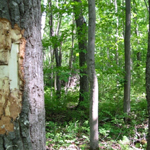Trees — Heal Thyself
Media Contact:
Jennifer Martin, (202) 720-8188
By Stacy Kish, CSREES Staff
September 16, 2008

A typical field site at Hopkins Forest, Williamstown, MA. Photo credit: Eric M. Kramer
Much like skin, trees heal themselves when they are injured by accident or disease. New insights into how trees recover from injuries may provide future benefits to the forestry industry and provide scientists the knowledge needed to develop trees that can withstand shifts in climate.
With funding from the USDA's Cooperative State Research, Education, and Extension Service (CSREES), scientists in Massachusetts mapped out the process that trees undergo in order to repair surface damage.
The key is wood grain, the neat, parallel packaging of the many tiny hollow tubes and cells that make up the wood itself. Since these tubes conduct water from roots to leaves, the maintenance of a continuous grain pattern is critical to the survival of the tree. Grain pattern has also evolved to make the tree strong and durable.
When a tree is injured, these cells regenerate in a pattern that appears to "flow" around the wound, producing the characteristic knots on the plant's surface. The question that has plagued plant scientists is how these cells reorient in order to flow around the wound. If the cells point into the wound, the tubing hits a dead end, effectively cutting off the supply of water and nutrients to the tree.
"When the tree is injured, the cells have a sophisticated decision to make," said Eric Kramer, associate professor of physics at Bard College at Simon's Rock, MA. "By diverging around the wounded area, the cells can continually supply nutrients and water to other parts of the tree."
Kramer and colleague Jennifer Normanly at the University of Massachusetts at Amherst, discovered that the hormone auxin plays an essential role in the coordination, growth, and reorientation of cells as the tree heals.
Auxin is a plant hormone responsible for cell growth and development. The scientists discovered that an auxin gradient develops around the wound. The gradient develops because auxin moves down the trunk of the tree. So, the concentration of auxin is high above the wound and low below the wound.
The auxin gradient triggers the reorientation of wood-forming cells. Thus, the water and nutrient conducting tubes of newly formed wood divert around the wound.
To better understand how the cells reorient as a tree wound heals, the scientists developed a computer model to animate cell growth and rotation. The model results support the auxin gradient idea and the resulting growth and orientation of cells as the tree heals.
"After 10 years of study, the results of this project brought this idea out of the realm of science fiction and made it a reality" stated Kramer.
Future work in this area may provide scientists the knowledge needed to improve tree resistance to drought conditions. The lumber industry can use this knowledge to develop trees with consistent wood grain patterns that result in stronger lumber. Finally, this information may help scientists understand how to develop specialized wood grain patterns for ornamental purposes.
CSREES funded this research project through the National Research Initiative Biobased Products and Bioenergy Production Research program. Through federal funding and leadership for research, education, and extension programs, CSREES focuses on investing in science and solving critical issues affecting people's daily lives and the nation's future. For more information, visit www.csrees.usda.gov.
###
Last Updated: 09/16/2008





